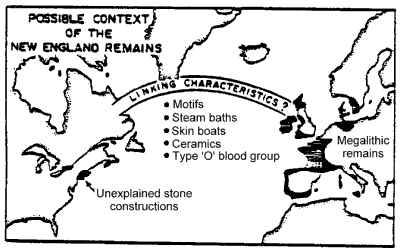The Stone Enigmas Of New England
Beginning with the maze of walls, courtyards, and chambers that characterize New Hampshire's Mystery Hill site, M.F. Doran and B.H. Kunnecke review the various types of anomalous stone structures found in northeastern North America. Three major classes are recognized:
- Covered passageways up to 25 feet in length and analogous to Cornish fogous.
- Beehive chambers, such as the 10-foot-high chamber at Upton, Massachusetts.
- Dolmen-like constructions, as exemplified by the 60-ton "balancing boulder at North Salem, New York. Termed a "glacial erratic" by most, the North Salem stone seems distinctly unlike most erratics and more like some European dolmens.
Noting that radiocarbon dates from Mystery Hill go back to more than 1,000 B.C., Doran and Kunnecke feels that these stone enigmas should receive professional attention in the context of world distributions of blood groups and other evidence of early, frequent transoceanic contacts.
(Doran, Michael F., and Kunnecke, Bernd H.; "The Stone Enigmas of New England," Anthropological Journal of Canada, 15:17, No. 2: January 1978
Reference. Many more "stone engimas" are detailed in Ancient Man. This Handbook is described here.

